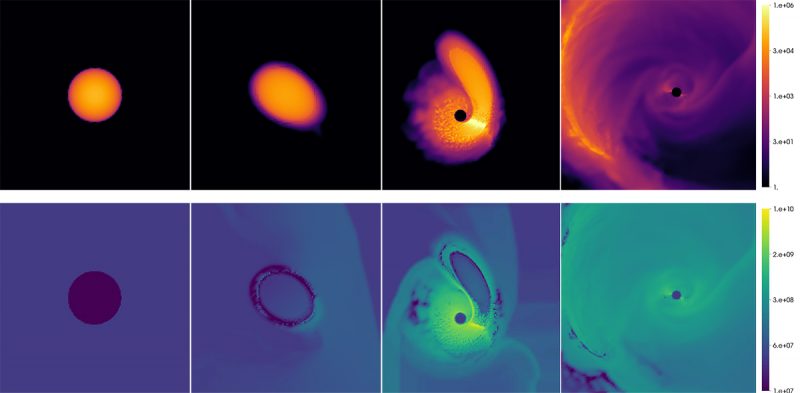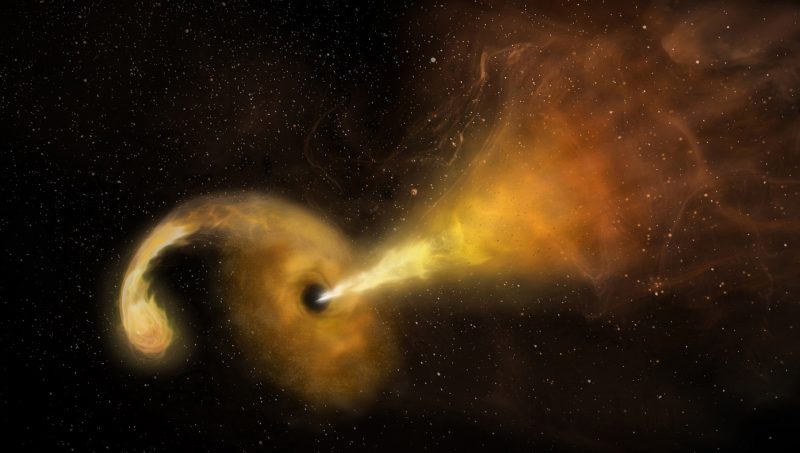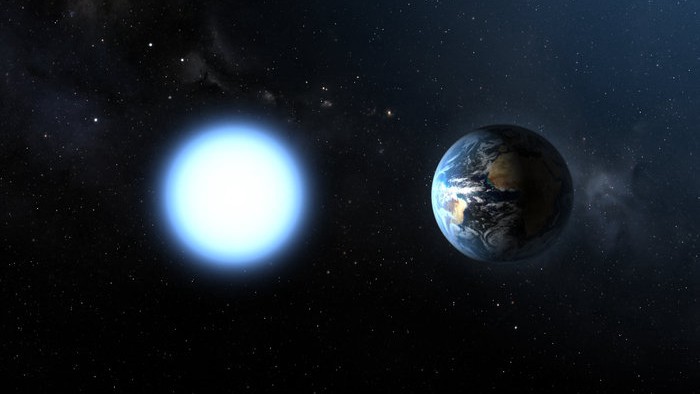
Just like living things, stars are born, they live and then they die. But did you know that, in some cases, a “dead” star might be reignited, if only for a few seconds? That is the finding from a new peer-reviewed study by astrophysicist Chris Fragile, which was published in The Astrophysical Journal on August 16, 2018. The research focuses on computer simulations showing what happens when a star or other object passes too close to a black hole. One finding is of particular interest. The work suggests a way in which a black hole can bring a white dwarf star – the now-dead core of a once-sunlike star – fleetingly back to life.
Specifically, if the white dwarf passes close to a black hole, then it experiences simultaneous, intense stretching and compression, caused by the overwhelming tidal force from the black hole. During this tidal disruption event, which might last only seconds, nuclear fusion within the white dwarf might briefly reignite.
It’s the process of nuclear fusion that enables “living” stars, like our sun, to shine.

How likely is this scenario?
It is possible, according to Fragile’s study, but certain conditions have to occur first. The white dwarf has to pass relatively close to a black hole of intermediate mass , that is, about 1,000 to 10,000 times the mass of our sun. The white dwarf must pass close to the hole, within its tidal radius, which indicates the distance between the black hole and white dwarf at which the gravity of the black hole exceeds that of the white dwarf. At this radius, the black hole begins to rip the white dwarf apart. But, in Fragile’s scenario, the white dwarf passes within the tidal radius of the black hole for, at most, only a few seconds. That is enough time for nuclear burning to restart inside the white dwarf and – through the process of nuclear fusion – for most of the white dwarf’s matter to be converted into other elements before the star blows itself apart.
As of now, astronomers have not yet discovered many intermediate-mass black holes, although this doesn’t mean that large numbers of them don’t exist. It might just mean they are hard to find. Fragile said in a statement from the College of Charleston:
It is important to know how many intermediate-mass black holes exist, as this will help answer the question of where supermassive black holes come from [because some models suggest supermassive black holes form via accretion from intermediate-mass black holes].
Finding intermediate-mass black holes through tidal disruption events would be a tremendous advancement.
As for tidal disruption events, astronomers haven’t yet observed many of those either, only about a dozen or so. None of those observed are thought to involve a white dwarf star. Tidal disruption events that do involve a white dwarf should be easily detectable, however. Fragile said such events can produce huge electromagnetic radiation outbursts and even gravitational wave signals. He said current and future observing programs, such as the All Sky Automated Survey for SuperNovae (ASASSN), the Intermediate Palomar Transient Factory and the Large Synoptic Survey Telescope (LSST) will continue to search for them.

Tidal disruption events that do involve white dwarfs are still being studied by computer simulations, as well. Such simulations have already found that nuclear burning should be a common outcome. Closer approaches by the white dwarf to the black hole will produce the element iron, while more distant approaches will produce calcium. There should also be short bursts of gravitational waves powerful enough to be detected by future instruments.
The nuclear burning is an important aspect of a tidal disruption event, since the chemical makeup of the white dwarf is radically altered. The previous helium, carbon and oxygen found in a white dwarf are converted to elements closer to iron on the periodic table. Some of that affected material is flung out into space, where it will contribute to the birth of new stars and planets.

Black holes are often depicted as tearing apart any object that comes too close to them; that may be pretty much true, but sometimes that violent event can apparently also, at least very temporarily, reignite a star under certain circumstances. It’s a good example of how bizarre and unexpected the universe can be, and how modern technology can help find cosmic phenomena that were never even known to occur or exist before.
Bottom line: Tidal disruption events involving intermediate-mass black holes and white dwarf stars seem to be fairly rare, but they can seemingly do something that sounds impossible – briefly bring a star back to life.











